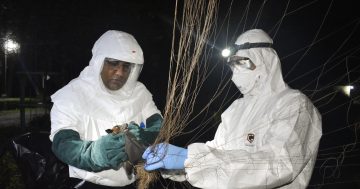Jeremy Farrar and Geeta Rao Gupta* say women’s representation is vital in tackling the coronavirus crisis.
 In February, a now-infamous photo made its rounds on social media.
In February, a now-infamous photo made its rounds on social media.
Posted by US Vice-President, Mike Pence, the image, which showed the members of the US Coronavirus Taskforce, left many asking a single question: where are the women?
This isn’t just a question of parity, it’s urgently needed.
Solving health emergencies like COVID-19 demands the best minds the world has to offer — in health systems strengthening, therapeutic research and development and more.
We know diverse teams lead to more innovation and neglecting half the talent pool limits our ability to make life-saving choices.
Leaders dictate where funding and research goes, from vaccine development to social safety nets.
Without women in these positions, subsequent decisions will not adequately address the hurdles women face.
Already, women comprise the bulk of the world’s frontline health workers, shouldering the burden of strenuous work, while increasing their own risk of infection.
With the novel coronavirus, women have played a central role: take China, where 90 per cent of the nurses and nearly half the doctors are women.
Beyond this, health emergencies impact men and women differently.
Sometimes the impacts are obvious, as was the case with pregnant women in the Zika outbreak.
Other times, they are more subtle.
Times of crises can exacerbate gender inequalities, like access to paid work, or leave women vulnerable to poorer health outcomes, like during the 2014 Ebola outbreak where resources diverted from obstetrics care contributed to a spike in maternal deaths.
While early studies suggest that men are at a higher risk of dying from the coronavirus than women (though little is known about its impact on pregnant women beyond new delivery room regulations in some places), women will likely be disproportionately affected in myriad ways, from the impact of school closures to a growing need for care of sick individuals at home.
We must also address the challenges women face as a result of prolonged quarantining, such as spikes in domestic violence.
Last year, the Global Preparedness Monitoring Board — co-convened by the World Bank Group and the World Health Organisation — called for more women leaders as a vital part of preparedness efforts.
Yet when analysing recent emergencies, it is all too clear that little has been done to ensure that women’s voices are reflected at the decision-making table and — likely, as a result — gender is often ignored in responses.
This is unsurprising — the lack of women in these roles reflects a global health field with stark gender inequalities.
Although women make up 70 per cent of the health workforce, they only comprise 25 per cent of senior leadership positions.
The 2020 Global Health 50/50 report, which evaluates gender parity in global health organisations, shows that decision-making bodies are still predominately male, and if current trends persist, gender parity at the CEO level is still 40 years away.
With more than 465,900 cases and over 21,000 deaths worldwide at the time of writing, the stakes are too high to disregard women’s voices.
Although the US Coronavirus Taskforce is majority men — and leaders of COVID-19 teams around the world, including the UK, are solely men — there are a number of talented women playing critical roles.
The US Taskforce does have two women, including one at the helm.
In addition, WHO’s COVID-19 technical lead, Maria Van Kerkhove, Anne Schuchat, the Principal Deputy Director of the US Centers for Disease Control, and Sun Chunlan, the most senior official leading on-the-ground efforts in Hubei Province, are doing incredible work.
This is an important start.
As the virus continues to spread, governments, research labs and health facilities should commit to ensuring that women in leadership is not the exception, but the norm.
Collecting sex-disaggregated data must also be prioritised so we can better understand the unique impact on women as compared with men.
More broadly, we must build the systems to support women’s leadership in global health before the next disaster strikes.
We can do this by equipping women with the skills, training and opportunities to rise to the top, and advocating for systemic changes — like closing the pay gap — to change the face of global health leadership.
As new COVID-19 cases emerge daily, we have no time to lose.
Prioritising women’s voices in the response will set us up for a more equitable, healthier future while saving lives today.
* Jeremy Farrar is Director of the Wellcome Trust. Geeta Rao Gupta is Executive Director of the 3D Program for Girls and Women.
This article first appeared at www.weforum.org.






